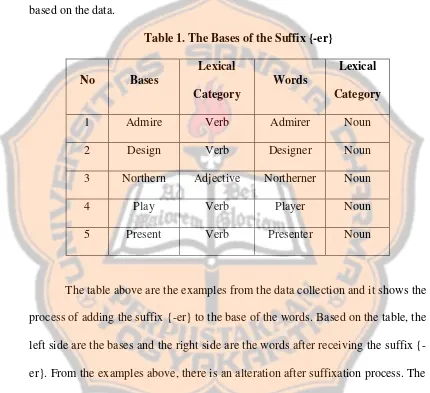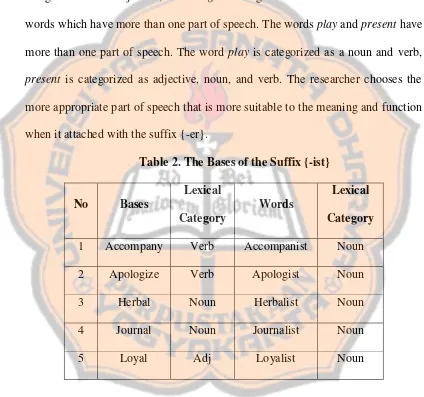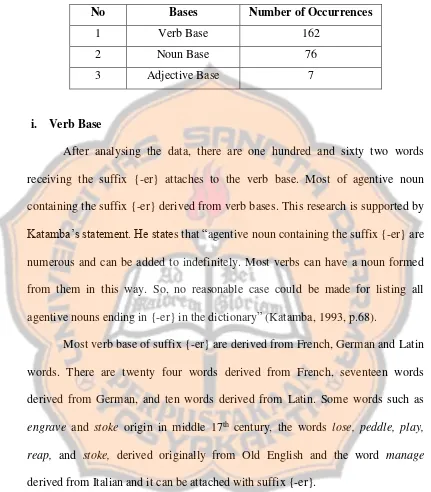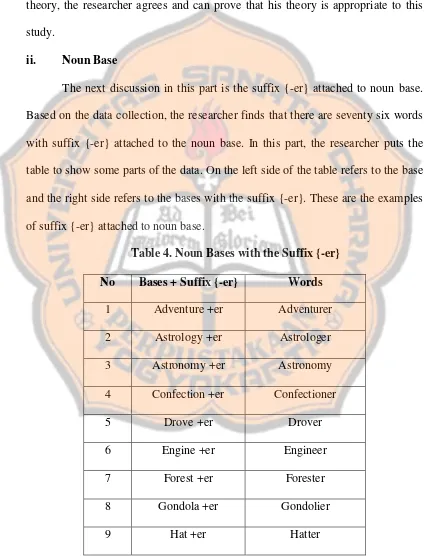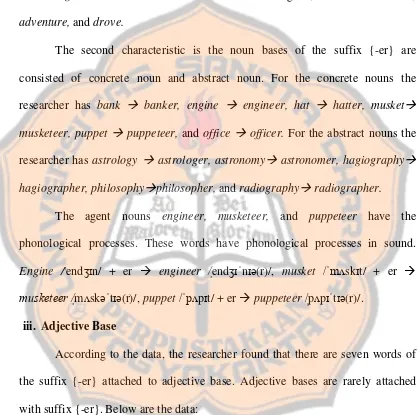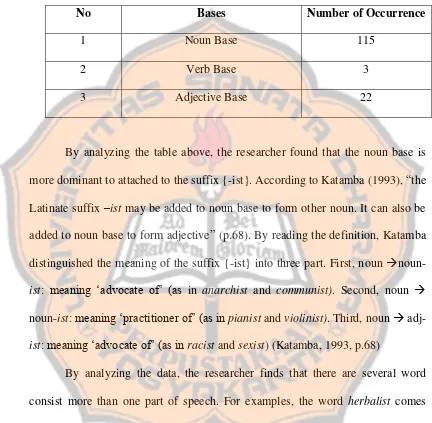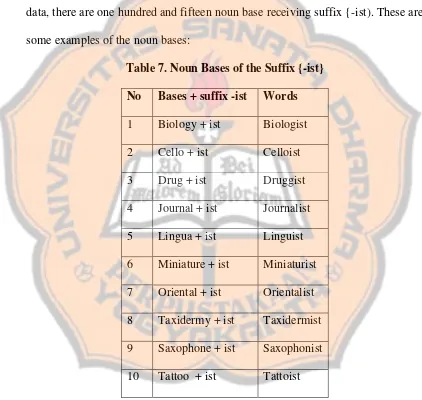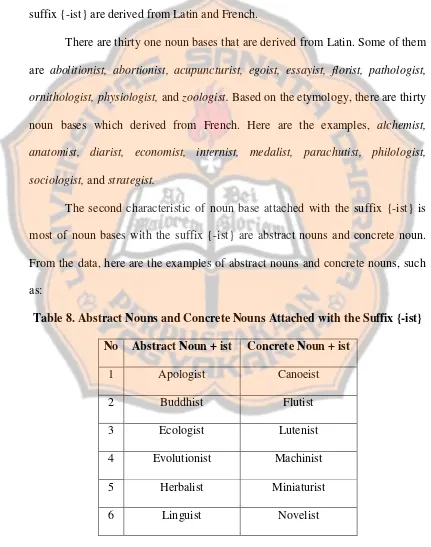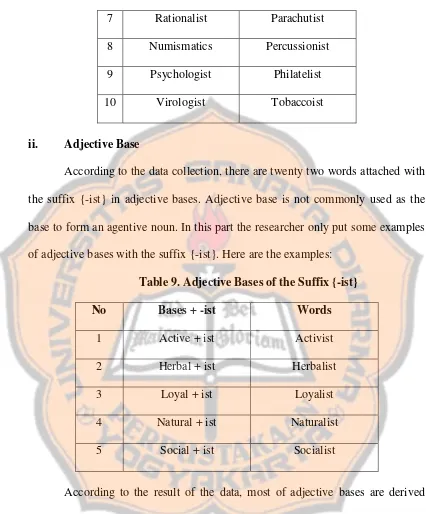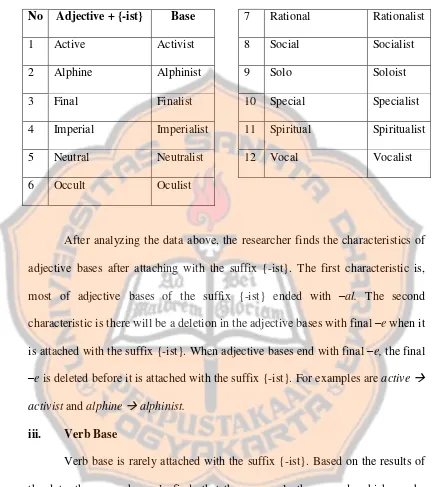MORPHOLOGICAL PROCESSES OF THE DERIVATIONAL
SUFFIXES {
–
ER} AND {-IST} IN AGENTIVE NOUNS
AN UNDERGRADUATE THESIS
Presented as Partial Fulfillment of the Requirements for the Degree of Sarjana Sastra
in English Letters
By
FRANSISKA RIZKINAULI Student Number: 144214087
DEPARTMENT OF ENGLISH LETTERS FACULTY OF LETTERS
UNIVERSITAS SANATA DHARMA YOGYAKARTA
i
MORPHOLOGICAL PROCESSES OF THE DERIVATIONAL
SUFFIXES {
–
ER} AND {-IST} IN AGENTIVE NOUNS
AN UNDERGRADUATE THESIS
Presented as Partial Fulfillment of the Requirements for the Degree of Sarjana Sastra
in English Letters
By
FRANSISKA RIZKINAULI Student Number: 144214087
DEPARTMENT OF ENGLISH LETTERS FACULTY OF LETTERS
UNIVERSITAS SANATA DHARMA YOGYAKARTA
iv
STATEMENT OF ORIGINALITY
I certify that this undergraduate thesis contains no material which has been
previously submitted for the award of any other degree at any university, and that,
to the best of my knowledge, this undergraduate thesis contains no material
previously written by any other person except where due reference is made in the
text of the undergraduate thesis.
Yogyakarta, December 12, 2018
v
LEMBAR PERNYATAAN PERSETUJUAN PUBLIKASI KARYA ILMIAH UNTUK KEPENTINGAN AKADEMIS
Yang bertanda tangan di bawah ini, saya mahasiwa Universitas Sanata Dharma
Nama : Fransiska Rizkinauli Nomor Mahasiswa : 144214087
Demi pengembangan ilmu pengetahuan, saya memberikan kepada Perpustakaan Universitas Sanata Dharma karya ilmiah saya yang berjudul
MORPHOLOGICAL PROCESSES OF THE DERIVATIONAL
SUFFIXES {
–
ER} AND {-IST} IN AGENTIVE NOUNS
beserta perangkat yang diperlukan (bila ada). Dengan demikian saya memberikan kepada Perpustakaan Universitas Sanata Dharma hak untuk menyimpan, mengalihkan, dalam bentuk media lain, mengelolanya dalam bentuk pangkalan data, mendistribusikan secara terbatas, dan mempublikasikannya di internet atau media lain untuk kepentingan akademis tanpa perlu meminta ijin kepada saya maupun memberikan royalti kepada saya selama tetap mencantumkan nama saya sebagai penulis.
Demikian pernyataan ini saya buat dengan sebenarnya.
Dibuat di Yogyakarta
Pada tanggal 12 Desember 2018
Yang menyatakan,
vi
Hail Mary, full of grace
The Lord is with thee
Blessed are thou amongst women
And blessed is the fruit of thy womb, Jesus
Holy Mary, Mother of God,
pray for us sinners,
vii
This page is dedicated to
My beloved parents
Apul Tamba
and
viii
ACKNOWLEDGEMENT
First of all, I would like to express my gratefulness to Jesus Christ, Mother
Mary, Saint Joseph, and Saint Claudius as my saviors of my life who always love
and blessing me. I am grateful because of Their help, mercy and blessing, I could
finish my undergraduate thesis. I also would like to express my deepest gratitude
to my beloved family, namely Apul Tamba, Hotdi Henrika Naibaho, Michael
Kevin Tamba, and Alfred Hisar Tamba. I can be the best of me because I always
get the best support, advice, and love from my best family.
I would like to express my deepest gratitude to my thesis advisor Dr. Fr.
B. Alip, M.Pd., M.A. for patiently understanding, guiding, and helping me from
the beginning until I finished my undergraduate thesis. I also would like to thank
my co-advisor and my academic advisor, Ms. Wedhowerti, M.Hum. who has read
and given me suggestions and detail corrections for my thesis. My gratitude is
also due to all of the lectures and staffs in English Letters Department for helping
and supporting me in every condition.
I give my deepest thanks to my beloved best friends namely, Koido,
Windy, Novi, Trisna, Kak Chitra, Daite, Daniel, Rani, members of KitKat,
members of Cacing Naga OTW SS and all of my friends and every one I cannot mention one by one for the support and love in every situation and during the
processing of finishing my undergraduate thesis..
The last I thank everyone who never stops sending me prayers during the
process of finishing my undergraduate thesis.
ix
d. The Derivational Affixes... 14
x
C. Method of the Study ... 18
1. Data Collection... 18
2. Data Analysis ... 19
CHAPTER IV: ANALYSIS (RESULTS AND DISCUSSIONS) ... 21
A. The Bases Receiving the Suffixes {-er} and {-ist} ... 22
1. Lexical Category of the Bases... 22
a. Bases Attached to the Suffix {-er} ... 25
i. Verb Base ... 26
ii. Noun Base... 28
iii. Adjective Base ... 30
b. Bases Attached to the Suffix {-ist} ... 31
i. Noun Base... 33
ii. Adjective Base ... 35
iii. Verb Base ... 36
B. The Distributions of the Agentive Suffixes {-er} and {-ist}. ... 37
1. The Application of the Suffix {-er} ... 40
2. The Application of the Suffix {-ist} ... 43
CHAPTER V: CONCLUSION ... 47
REFERENCES ... 50
APPENDICES ... 51
Appendix 1 ... 51
Appendix 2 ... 53
Appendix 3 ... 54
Appendix 4 ... 54
Appendix 5 ... 56
xi
LIST OF TABLES
No Table Page
1. Table 1. The Bases of the Suffix {-er} 23 2. Table 2. The Bases of the Suffix {-ist} 24 3. Table 3. Number of Parts of Speech of Words with the Suffix
{-er}
26
4. Table 4. Noun Bases with the Suffix {-er} 28 5. Table 5. Adjective Bases of the Suffix {-er} 30 6. Table 6. Number of Parts of Speech Words with in the Suffix
{-ist}
32
7. Table 7. Noun Bases of the Suffix {-ist} 33 8. Table 8. Abstract Nouns and Concrete Nouns attached with the
suffix {-ist}
34
xii ABSTRACT
RIZKINAULI, FRANSISKA. (2018). Morphological Processes of the Derivational Suffixes {-er} and {-ist} in Agentive Nouns. Yogyakarta: Department of English Letters, Faculty of Letters, Universitas Sanata Dharma.
Language has the most important role in people’s daily life. As time goes
by language has been developing to complete human needs. Affixation is one of
the examples of language’s development. Affixation is one of language
developments that is always used by people in their daily life. There are many new words created by using affixation. Affixation is divided into three parts, which are prefix, infix, and suffix.
In this study the researcher focuses on the suffixes {-er} and {-ist} in agentive noun. These suffixes are analyzed because in daily life they are often used by people to perform agentive noun. To obtain a deeper analysis, the researcher has two problem formulations, (1)Based on the lexical category, what bases receive the suffixes nominalizer suffixes {-er} and {-ist} in agentive noun? (2) Based on meaning and etymology, what is the distribution of the agentive suffixes {-er} and {-ist}?
The data of this study are taken from Hornby’s Oxford Advanced
Learner’s Dictionary (2015). The agentive noun that contains the suffixes {-er}
and {-ist} are the data of this study. The researcher took two hundred and forty five words with the suffix {-er} and one hundred and forty words with the suffix {-ist}. The researcher took the words by reading the whole dictionary and took every word that is included into agentive noun.
xiii ABSTRAK
RIZKINAULI, FRANSISKA. (2018). Morphological Processes of the Derivational Suffixes {-er} and {-ist} in Agentive Nouns. Yogyakarta: Program Studi Sastra Inggris, Fakultas Sastra, Universitas Sanata Dharma
Bahasa memiliki peran yang sangat penting dalam kehidupan sehari-hari manusia. Seiring berjalannya waktu, bahasa selalu berkembang untuk melengkapi kebutuhan manusia. Proses imbuhan adalah salah satu contoh dari perkembangan bahasa. Proses imbuhan adalah salah satu perkembangan bahasa yang selalu digunakan manusia dalam kehidupan sehari-harinya. Ada banyak kata-kata baru yang dibentuk dengan menambahkan proses imbuhan. Proses imbuhan itu sendiri dibagi menjadi tiga bagian yaitu, awalan, sisipan, dan akhiran.
Dalam penelitian ini, penulis fokus kepada akhiran {-er} dan {-ist} yang terdapat dalam kata benda orang. Akhiran ini dianalisis karena didalam kehidupan sehari-hari akhiran tersebut sering digunakan untuk memggambarkan profesi seseorang. Ada dua pokok bahan permasalahan yang telah dirumuskan untuk melakukan penelitian yang lebih dalam: (1) Berdasarkan kategori leksikal, basis apa saja yang bisa menerima akhiran {-er} dan {-ist} pada kata benda orang? (2) Berdasarkan arti dan etimologi, apa saja distribusi kata benda orang pada akhiran {-er} dan {-ist}?
Data dalam penelitian ini diambil dari Oxford Advanced Learner’s Dictionary (2015) yang disusun oleh Hornby. Kata-kata benda orang yang mengandung akhiran {-er} dan {-ist} merupakan data dalam penelitian ini. Penulis mengambil dua ratus empat puluh lima kata dengan akhiran {-er} dan seratus empat puluh kata dengan akhiran {-ist}. Penulis mengambil kata-kata tersebut dengan membaca keseluruhan kamus dan mengambil setiap kata yang merupakan kata benda orang.
1 CHAPTER I INTRODUCTION
A. Background of the Study
The use of language cannot be separated from people’s activities. In daily
life, people always need language to perform their activities and communicate
with each other. When people know and understand the language, people can
speak and communicate with others who know language. Communication delivers
messages or ideas to others. Therefore, people understand the language they use.
Language and people have a connection to convey the purpose of communication.
In order to make a good conversation, people have known the words of the
language that they use.
According to Fromkin, Rodman, and Hyams (2014), words are important
part of linguistic knowledge and a constitute component of our mental grammar
(p. 33). On the other hand, without knowing a language and having several words,
we would be unable to convey our idea through the language and the
communication will not happen.
There are many studies which discuss about language. Morphology is one
of linguistics study which study about language and word formation. Fromkin,
Rodman, and Hyams (2014) argue that morphology is the study of the internal
structure of words, and of the rules by which words are formed (p. 37). Therefore,
people have knowledge of knowing the use of word structure and the meaning of
The most important component of word structure is morpheme. Morpheme
itself is the smallest unit of language that carries information about the meaning
and function of the word. According to Szymanek (1988), the definition of
morpheme is the smallest unit of language that carries information about the
meaning (p.14). Every morpheme has different forms and from the different forms
can created many new meaning from the basic word. O’Grady (1980) states that a morpheme that can stand by its-self is called free morpheme and the morpheme
that must be added to another element is called bound morpheme (p. 56). Based
on the examples small, carry, inform, mean are termed free morphemes, and {–
est}, {-ation}, {-ing} are called affixes that instances of bound morpheme.
Affixation is the most common process that is used by people every day
and it is used because most of the new words created by using affix. The result
from the process of affixation is noun derived from verb, adjective derived from
adverb, and adjective derived into noun. Affixation is bound morpheme which
divided into three part, prefix, infix and suffix. There are many affixes that
applied in English Language. In prefix there are {anti-},{de-}, {dis-}, {ex-},
{in-}, {mis-{in-}, {un-{in-},{re-}. In suffix there are {–able}, ion}, er}, ing}, ive}, ed}, al}, ment}, ful}, ic}, ness}, less}, ous}, ity}, ly}, en},
{-ate}, {-ize}, etc Adding an affix can created a new meaning and it can be
derivational affixes and inflectional affixes. The transformation of affixes brings
out the characteristic of words. According to Szymanek (1989) “the field of morphology is conventionally divided into two components, they are inflectional
morpheme is the new word with a new meaning is derived when they are added to
a base and inflectional morpheme never change the grammatical category of the
stem to which they are attached (Fromkin et al, 2014, pp. 44-46).
Sometimes people have troubles determining the category of the base to
which an affix is added. For examples in player the base play is used as a verb (to
do things for pleasure) and as noun (a person who takes part in game or sport). By
attaching affixes to the base of words, it is difficult to identify the category.
However, people should consider using and choosing appropriate form.
In this study, the researcher focuses on morphological process of
derivational suffixes {-er} and {-ist} in agentive noun. According to Szymanek
(1988) “deverbal nominalizations traditionally referred to as Names of Agents are formed in English very productively, potentially from a vast majority of verbs” (p.174). However, from Szymanek’s statement, the researcher is interested to analyse the suffixes {-er} and {-ist}. Because in English, these suffixes always
produce in people daily life. In daily life, people always find and use these
suffixes to form agentive noun and create a new form of agent with these suffixes.
For examples are teacher, farmer, gardener, artist, scientist, violinist, etc. By
adding the suffix {–er} to the verb base and noun base, the formed verb will change into noun and noun will change into noun. The importance of studying
about suffixes {-er} and {-ist} is people can understand the characteristic of the
base, whether it is acceptable or not. However, people can minimize their misuse
In this study, the data are taken from Oxford Advanced Leaner’s Dictionary of Current English (9th Ed). (2015). The researcher takes more than
200 agentive nouns that receive suffix {-er} and more than 100 agentive nouns
that receive the suffix {-ist}. The researcher collects two hundred words because
there are many agentive nouns which receive suffixes {-er} and {-ist} and also it
helps the researcher to analyze clearly.
B. Problem Formulation
Based on the background of the study above there are two questions as the
problem formulations, they are:
1) Based on the lexical category, what bases do receive the nominalizer
suffixes {-er} and {-ist} in the agentive nouns?
2) Based on meaning and etymology, what is the distribution of the agentive
suffixes {-er} and {-ist}?
C. Objectives of the Study
According to the problem formulation, this study has two objectives. First,
the researcher know what kind of words base that receive the nominalizer suffixes
{–er} and {–ist} in agentive noun. The second objectives of this study is to find and identify the distributon of agent the suffixes {-er} and {-ist} to the bases
based on meaning and etymology. In this study, the researcher wants to classify
the base of the suffixes {-er} and {-ist} based on the part of speech. Next, the
bases through the meaning and etymology. The distribution here is understood
when each suffix is used based on the meaning and etymology.
D. Definition of Terms
In this part the researcher provides the definition of terms used in this
study. The definitions are going to be discussed are morphology, affixes,
derivational morphology,agentive nominalizations.
The first terminology is morphology. Morphology is the study of words structure.
According to Fromkin, Rodman, and Hyams (2014), “morphology means the study of the internal structures of words, and of the rules by which words are formed. Morphology itself consists of two morphemes, there are morph + ology. The suffix –ology means ‘branch of knowledge’, so the meaning of morphology is ‘the branch of knowledge concerning (word)
forms’” (p.33).
Most of English words are morphologically complex. They can be
separated into the smaller units that are meaningful. The examples of words which
are morphologically complex are teach-er, violin-ist, where teach refers a verb
that perform something to someone and teacher refers to show the agent who does
the verb. Next, violin refers to a noun and violinist refers to someone who plays
violin.
The second terminology is affixes. Fromkin, Rodman, and Hyams (2014)
states that affixes are bound morphemes and they may attach at the beginning of
words, the end of words, in the middle, or both at the beginning and at the end of
words (p.40). Szymanek (1989) also states that there are many types of affixation
The most familiar affixation phenomena are prefixes, suffixes, and infixes.
A prefix is an affix attached before the root, for examples are dis-like, re-mark,
and in-accurate. A suffix is an affix attached after the root, for examples are
play-er, and sleep-ing, cat-s. An infix is an affix inserted between the root.
The third terminology is morpheme. Based on Crystal (2008) “morpheme is the minimal distinctive unit of grammar, and the central concern of
morphology” (p.313). Through this definition morpheme is the smallest meaning of the words. According to Crystal (2008) “morphemes are commonly classified into free forms (morphemes which can occur as separate words) and bound forms
(morphemes which cannot so occur mainly affixes)” (p.313).
The fourth terminology is derivational morphemes. According to Fromkin, Rodman, and Hyams (2014), bound morphemes like –ify, -cation, and – arian are called derivational morphemes. Derivational morphemes are morphemes which are added to a base creating a new word with a new meaning. The result
from the addition of a derivational morpheme is called a derived word (p.44).
The last terminology is agentive noun. According to Szymanek (1989),
“agentive noun traditionally referred as names of agents. Agentive nouns are formed in English very productively.” (p.174). Based on Szymaenk’s statement above, agentive noun is a person who does something according to the bases. For
7 CHAPTER II
REVIEW OF LITERATURE
A. Review of Related Studies
In this part, the researcher takes two related studies that are related to
morphology. The first previous study was written by Denista and Alip (2014)
entitled “The Distribution of the Agentive Nominalizer of the Suffixes {-er} and {-an}”. In this study, the previous researchers discuss about how the distribution of the agentive nominalizer of the suffixes {-er} and {-an}. This study focuses on
the suffixes {-er} and {-ist} because people nowadays always use these suffixes
in their daily life and they usually use these suffixes to categorize agentive
nominalizer. From this study, the researchers find the characteristics of stems that
are receiving the suffixes {–er} and {-an}, the meaning which are introduced by the suffixes {–er} and {–an} and also the distributions of the allomorphs of suffixes {–er} and {-an}.The data of this study are morphemes and affixes. The previous study uses Hornby’s Oxford Advanced Learner’s Dictionary (year of
2000) as the data.
The result of this study is suffix {-er} are attached to certain verbs,
adjectives and nouns. The suffix {-an} is attached to certain adjectives and noun.
From the data analysis, the suffix {-er} is mostly attached to transitive verbs to
create a new meaning. However, it is not impossible for intransitive verbs to have
Based on previous studies, the researcher has the similar topic with the
previous researcher. Both of the studies discuss about suffixes in agentive noun.
The differences from this study are the variety of the suffixes. In previous study,
the researchers focus on the suffixes {-er} and {-an}, but in this study the
researcher focuses on the suffixes {-er} and {-ist}. Another differences are the
previous study identifies the morphophonemic processes and the allomorph of the
suffixes {-er} and {-an}, but in this study the researcher focuses on the base of the
suffixes {-er} and {-ist} and the distribution of the agentive suffix {-er} and suffix
{-ist}. By comparing to this study, the previous researcher focuses and analyses
morphophonemic processes occured in the agentive noun.
The second related study is written by Samuel Kristian (2014) entitled “A
Morphological Study of the English Derivatonal Suffixes {-ence} and {-ance}”. This study discusses about the suffixes {-ence} and {-ance} in Oxford Advenced
Learner’s Dictionary. The researcher of this undergraduate thesis uses
morphological approach to analyze his data. In his analysis, the researcher
discusses the morphological structure of suffixes {-ence} and {-ance}. In his
research, he tries to find the stem which can be attached to the suffixes {-ence}
and {-ance}, the meaning brought by the suffixes {-ence} and {-ance} ater they
are attached to the stem, and to find the allomorph and morphophonemic
processes are involvedin suffixes {-ence} and {-ance}. In this research, the
researcher try to find the bases do receive the nominalizer suffixes {-er} and {-ist}
in the agentive nouns and the distribution of attaching the suffixes {-er} and {-ist}
The previous study has similar method to analysis the data which is
morphological approach. Both of the research disccuses about derivational
suffixes. The difference between these study is that the type of suffixes. The
previous study discusses about the suffixes {-ence} and {-ance} while this study
discusses about the suffixes {-er} and {-ist} in agentive noun.
The third study was written by Nursanti (2013) entitled “A Morphological Analysis on the Derivational Affixes Suffixes {–ion} and {–ation} Used in
Oxford Advanced Learner’s Pocket Dictionary”. This undergraduate research is
about the morphological analysis on derivational suffixes {–ion} and {–ation} in
Oxford Advanced Learner’s Pocket dictionary. The previous research analyses and clarifies the similarities and differences between the usage of suffixes {–ion} and {–ation} in Oxford Advanced Learner’s Pocket Dictionary.
She describes the characteristics of the suffixes {–ion} and {–ation}. The usage of the suffixes {-ion} and {-ation} have the similarities in the function
category. The word category such as verb and adjective are followed by the
suffixes {-ion} and {-ation}, the grammatical category will change into noun
category. It is called derivational affixes noun forming.
However, the noun category which is followed by the suffixes {-ion} and
{–ation} do not change the grammatical category, because there is no change between noun into noun. The similarities between the uses of the suffix {-ion} and
{-ation} are the functions of each suffix. The differences between the uses of
In this undergraduate thesis, the researcher develops this study and
discover new ideas with suffixes {-er} and {-ist}. The similarity between the
previous study and this study is the data. Both of these studies discuss the type of
affix. Both of these studies take suffixes as the object to analyze. In this study,
researcher tries to find the bases that can receive the suffixes {-er} and {-ist} in
agentive noun and analyses the distribution of attaching the suffixes er} and
{-ist} to the bases. The researcher uses Hornby’s Oxford Advanced Learner’s
Dictionary 9th edition (2015) as the data and collect more than 200 words which are contained with the suffixes {-er} and more than 100 words which are
contained with the suffixes {-ist}. These suffixes are always used by people in
their daily communication to state someone who does something.
B. Review of Related Theories 1. Theory of Morphology
Syzmanek (1989) defines “morphology is the branch of linguistics dealing with internal structure and formation of words. Morphology define a two concepts
of morphological analysis, there are ‘word’ and ‘morpheme’” (p.13). According to Mark Aronoff and Kirsten Fudeman (2004), “in linguistics morphology refers to the mental system involved in word formation or to the branch of linguistics
that deals with words, their internal structure, and how they are formed” (p.2). From those theories, the researcher concludes that morphology is the study
dealing with the word formation and also branch of linguistics that always relates
know and classify the characteristics of the words and how to create words in a
language.
In this study, the researcher applies the theory of morphology. Therefore,
by applying this theory to the research, the researcher is able to recognize how to
identify the words or morphemes in English language and the distribution in
forming words.
a. Morpheme
Morpheme is derived from the Greek word morphe, meaning ‘form’ (Fromkin, et al, 2014, p.37). The classic definition from Hockett (1958) is “The smallest individually meaningful element in the utterances of language” (p.123).
O’Grady and Videa P.de Guzmain (1980) say “the most important component of word structure is the morpheme, the smallest unit of language that carries
information about meaning and function” (p.55).
It means that morpheme is the smallest unit of the words with a
grammatical function. For example, the words happy, sad, think, drink, beauty, tall, pink, and blue are morphemes. The words playing, beautiful, desks, suffixes, hunters, manly and gentleman are the words which contain more than one
morpheme. A morpheme consists of a word that can be divided into smaller
meaningful parts and carry information about their meaning and the function.
“The meaning of morpheme must be constant. For example, the agentive morpheme {-er} means ‘one who does’ in words like singer, painter, lover, and worker, but same sounds represent the comparative
All languages use morpheme to create phrases and sentences. By knowing the
small meanings of morpheme, the language development will keep on growing to
create new words.
“Our morphological knowledge has two components: knowledge of the individual morphemes and knowledge of the rules that combine them” (Fromkin, et al, 2013, p.40). From the statement, the researcher concludes that morphemes can stand alone by themselves and also they must be attached to another
morpheme.
“Morphemes are further categorized into two classes: free morpheme and bound morpheme. A free morpheme can stand alone as an independent word” (Akmajian, et al, 2001, p.18). By knowing the classes of morpheme, the researcher concludes that the free morpheme is a morpheme which can stand
alone as an independent word and bound morpheme is a morpheme which cannot
stand alone and needs another morpheme to create a word. Based on the
definition, bound morpheme must be attached to another morpheme to create a
word. It means that bound morpheme must be followed by free morpheme to
create a word.
b. Derivational Morpheme
Derivational morpheme is a bound morpheme that creates a new word
with a new meaning (O’Grady et al, 2010, p.122). In other words, when the morphemes are attached to the base of word, it will create a new meaning and new
category for the new word. According to Fromkin, Rodman, and Hyams (2014),
morphemes. When they are added to a base, a new word with a new meaning is
derived. The result from the addition of a derivational morpheme is called a
derived word” (p.44). For example, the addition of {-er} to teach teacher
means ‘a person who teach’ and the addition of {-ing} to teach teaching means
‘the work of the teacher’. By adding the morphemes {-er} and {-ing} to the base of words, people must know the characteristics and the rules of the derivational
morpheme if it is acceptable or not.
c. Affixation
Szymanek (1989) states that “affixation is a morpheme added to the base of the words. In other words, affixation is the combination of a bound morpheme
with a stem or root” (p.63). Most of the new words are created by using affixation. Affixation is the most common process to form the new words. “An affix is a morpheme which only occurs when attached to some other morpheme or
morphemes such as root or stem or base” (Katamba,1993,p.44). In English language, there are three main types of affixation, they are suffixation,
preffixation, infixation.
i. Suffix
In this study, the researcher focusses on suffixation of {-er} and {-ist}.
According to Szymanek (1989) “suffixation consists in attaching a suffix to a base or root. A suffix is an affix which follows the base-form” (p.63). In other words, suffix is adding an affix after the base of a word, for examples teach + {-er} teacher, farm + {-er} farmer. By attaching suffix {-er} after the base of words,
ii. Prefix
According to Katamba (1993), “a preffix is an affix attached before a root or stem or base like re-,un-, and –in” (p.44). In other words, prefix is adding an affix in front of the base of the word to change the meaning. The examples are
{dis-} + honest dishonest, {un-} + usual unusual, {in-} + complete incomplete,{re-} + do redo, and {de-} + activate deactivate.
iii. Infix
“An infix is an affix inserted into the root itself” (Katamba, 1993, p.44). Another theory from Szymanek (1989), he states “the term infixation describes a morphological process whereby a bound morpheme (inflectional or derivational is
inserted into the base form (usually, into a root-morpheme)” (p.65). The definition means, an infix is adding an in the middle of the base or stem or root of the words
to create a new meaning. Infixes are relatively rare in English language, but infix
can be found in another language.
d. The Derivational Affixes
According to Akmajian et al (1988), “derivational affixes often change the part of speech of the base morpheme” (p.81). In other words, derivational affixes can change the meaning of the base and create new words from the base.
i. Suffix {-er}
There are many words that can be attached with the suffix {-er}. Most of
them are used to formed agentive nominalizations and instrument
nominalizations. In this study, the researcher focuses on agentive nominalizations.
“the principal agentive suffix in English is {-er}. Its remarkably high productivity is attested by the fact that it is frequently added to recently coined verbs. It is true
to say that the suffix {-er} is the first choice when it comes to deriving an agent
noun from a verb” (p.176). According to Quirk (1972), “suffix {-er} added to nouns to form personal and innanimate nouns. There are varied meanings from
suffix {-er} they are, something having X, inhabitant of X, and maker of X.
Examples are glover, teenager, and Londoner (p.994).
ii. Suffix {-ist}
After the suffix {-er}, the suffix {-ist} also commonly used in people’s daily life. The suffix {-ist} also has the similar function with suffix {-er}, both of
them are used to form agentive noun. According to Katamba (1993) “by suffixing {-ist} we can form a very large number of nouns with the meaning advocate of,
follower of supporter of or partitioner of whatever is designed by the input noun” (p.68). Quirk (1974) states that “the suffix {-ist} added to nouns or adjectives to form personal nouns or adjectives. The meaning is member of a party, occupation.
For instances masochist, racialist, Buddhist, violinist, stylist, and loyalist (p.996).
C. Theoretical Framework
In this study, there are several theories that are used for the data analysis.
Morphology is one of the primary theories that are used to analyse this study.
Morphology is related to word formations in affixation which contains suffix.
From the morphological theory, the researcher can understand the processes of
morpheme, and also the change of the word’s class. In this case, morphology theory helps the researcher to find the characteristic and the function of the
suffixes {-er} and {-ist}.
There are two problem formulations in this study. The first problem is to
identify the bases receive in suffixes {-er} and {-ist}. In order to analyses this
problem, the reseracher uses the theory of affixation to identify the process of the
suffixes {-er} and {-ist} when they are attached to the base of words..
The second problem in this study is to identify the distribution of the
agentive suffixes {-er} and {-ist}. In this problem, the researcher use theory of
derivational morpheme to help and find the function in each suffixes. The
researcher tries to find the meaning of the suffixes {-er} and {-ist}. What kind of
17 CHAPTER III METHODOLOGY
A. Object of Study
The objects of the studies are the words contain morpheme and affixation.
Type of the affixations that are used in this study are suffixes {-er} and {-ist}. The
words are taken from Oxford Advanced Learner’s Dictionary of Current English
(9th ed).(2015). In this study the researcher takes more than two hundred words that receives the suffixes {-er} and {-ist} at the end of the base of words. The
researcher takes the words which are agentive nouns. The researcher collects two
hundred words because there are many agentive nouns which are receiving the
suffixes {-er} and {-ist} and also it helps the researcher to analyze the words
clearly.
B. Approach of the Study
In this study, the researcher uses theory of morphology as an approach in
analysing the agentive noun with the suffixes {-er} and {-ist}. The researcher uses
morphology because it is related to this study. Morphological approach is used to
analyse the agentive nouns with the suffixes {-er} and {-ist}. Fromkin, Rodman,
Based on the theories, morphology is related to derivational morpheme
which forms a word with new meaning and category by adding the suffixes {-er}
and {-ist} through the base of words. According to Fromkin, Rodman, and Hyams
(2013) “affixes are bound morphemes and they may attach at the beginning, the end, in the middle, or both at the beginning and end of a word” (p.40). Therefore, morphological approach is appropriate for this study because these theories help
the researcher to analyse and examine the words which are attached with the
suffixes {-er} and {-ist} in agentive nouns.
C. Method of the Study
In this study, the researcher conducts a library research which analyze the
agentive nouns with the suffixes {-er} and {-ist}. The researcher obtains the data
from reading the Oxford Advanced Learner’s Dictionary 9th edition. The method of this study is divided into two parts. The first is data collection and the second is
data analysis.
1. Data Collection
The data was taken from Oxford Advanced Leaner’s Dictionary of Current
English (9th Ed). (2015). The researcher chooses the agentive nouns that receive suffixes {-er} and {-ist} which are collected from Oxford Advanced Leaner’s
Dictionary of Current English (9th Ed). (2015). The researcher takes two hundred words to be analysed in this study. The data collection takes the words randomly
and also the bases should contain the suffixes {-er} and {-ist}. In this study, the
which receive suffixes {-er} and {-ist} and also it helps the researcher to analyse
the data clearly.
Oxford Advanced Leaner’s Dictionary of Current English (2015) is used
as a tool to answer the problem formulation in this study. The researcher chooses
Oxford Advanced Leaner’s Dictionary of Current English (9th Ed). (2015).,
because it provides the International Phonetic Alphabet (IPA) that helps the
researcher to find the lexical category.
2. Data Analysis
In this study, the researcher takes some steps to analyse the data. First the
researcher collects and chooses the agentive nouns which are receiving the
suffixes {-er} and {-ist} from dictionary. Before choosing the words, the
researcher should know and check the base and the base after receiving the
suffixes {-er} and {-ist} because in this study the researcher wants to collect the
words base on the agent nouns. In order to help the researcher finds all the words,
the researcher uses Oxford Advanced Leaner’s Dictionary of Current English (9th Ed). (2015). It is used to reduce the error in analysing the base and also to check the IPA based on the words receiving suffixes {-er} and {-ist}.
There are some steps to find and understand the functions of the suffixes
{-er} and {-ist}. The first step to answer this problem is to make a classification
of each base. The researcher uses tables to help answering these problems and
categorizing the suffixes {-er} and {-ist}. By categorizing the bases, the
researcher knows the category of the bases before the suffixes {-er} and {-ist} are
functions of the suffixes {-er} and {-ist} and also the characteristic of the words
receiving the suffixes {-er} and {-ist}.
Next, there is some steps to identify the distribution of the agentive
suffixes {-er} and {-ist} to the bases. The first step to answer this problem is
reading the Oxford Advanced Leaner’s Dictionary of Current English (9th ed.).(2015)., because it provides the complete meaning and the definition of the base. The second step is the researcher tries to analyse and understand the
meaning that is more appropriate to be attached with the suffixes {-er} and {-ist}.
After that, the last step is to collect the data into tables. Therefore, the researcher
can compare and analyse the distributions of attaching the suffixes er} and
21 CHAPTER IV
ANALYSIS RESULT AND DISCUSSION
In this chapter there are two problem formulations are discussed. This
chapter contains the analysis and results from the two problem formulations. The
first problem formulation is what bases receive the suffixes {-er} and {-ist} in
agentive noun and the second problem formulation is the distribution of attaching
the suffixes {-er} and {-ist} to the agentive nouns. The researcher collected the
agentive nouns which contain the suffixes {-er} and {-ist} as the data. After that,
the researcher analyses the data and concludes if the words that received the
suffixes {-er} and {-ist} have alteration in the meaning. Suffixes {-er} and (-ist}
are used to create new words from the base. By adding these suffixes er} and
{-ist}, they can change the lexical category of the words, they change the meaning
to another meaning but they still have relation. The type of this process is called
derivational suffix, where the new words have new meanings.
Answering the first problem formulation, the researcher uses Oxford
Advanced Learner’s Dictionary 9th edition (2015) as the main data of this study.
The researcher collects agentive nouns which are receiving the suffixes {-er} and
{-ist} from Oxford Advanced Learner’s Dictionary 9th edition (2015). The researcher chooses this dictionary because it provides the Standard English. The
dictionary provides the phonetic transcription, the part of speech, and specific
definition of the words. After that, the researcher finds and analyses the lexical
researcher finds the distribution of attaching the suffixes {-er} and {-ist} to the
bases of words. By analysing the base of the words, the researcher found some
bases have more than one lexical category. Based on the data, the researcher can
analyses the function of the suffixes {-er} and {-ist} by seeing the lexical category
according to the base of words.
A. The Bases Receiving the Suffixes {-er} and {-ist} 1. Lexical Category of the Bases
From the whole of the dictionary, the researcher discovers two hundred
and thirty eight words receiving the suffix {-er} and one hundred forty five words
receiving the suffix {-ist}. Akmajian et al (1988) say, “morphemes are further categorized into two classes: free morpheme and bound morpheme. A free
morpheme can stand alone as an independent word and a bound morpheme cannot
stand alone” (p.58). By analysing the whole words, all the bases are free morpheme. All the bases receiving the suffixes {-er} and {-ist} are free
morpheme because they can stand on their own. Suffixes {-er} and {-ist} are
bound morpheme because they cannot stand alone. They must be attached to free
morpheme to create a meaning. Mostly, the suffixes {-er} and {-ist} are used to
perform an agent noun. Suffixes {-er} and {-ist} are the most commonly used in
people’s daily activity and used them very productively.
All the words have lexical category to indicate the part of speech. The
function of the lexical category is to know the type or category or function of the
class of words. The main ‘parts of speech’ known as noun, pronoun, verb, adverb,
adjective, preposition, conjunction and interjection with article, participle and
others often added” (p.378). Every base in this data does not have the same lexical category. They have their own category as their function. Here are some examples
based on the data.
Table 1. The Bases of the Suffix {-er}
No Bases
Lexical Category
Words
Lexical Category 1 Admire Verb Admirer Noun
2 Design Verb Designer Noun
3 Northern Adjective Northerner Noun
4 Play Verb Player Noun
5 Present Verb Presenter Noun
The table above are the examples from the data collection and it shows the
process of adding the suffix {-er} to the base of the words. Based on the table, the
left side are the bases and the right side are the words after receiving the suffix
{-er}. From the examples above, there is an alteration after suffixation process. The
bases and the words after adding the suffix {-er} have a different part of speech.
The words admirer, designer, northerner, player, and presenter have a part of speech as noun. Adding the suffix {-er} to the base creates a new meaning
suffix er}. They are categorized as agentive nouns after receiving the suffix
{-er}.
The bases have different part of speech before adding the suffix {-er} and
it shows the function. The word admire is categorized as a verb, northern is
categorized as an adjective, and design is categorized as a noun. There are two words which have more than one part of speech. The words play and present have
more than one part of speech. The word play is categorized as a noun and verb,
present is categorized as adjective, noun, and verb. The researcher chooses the more appropriate part of speech that is more suitable to the meaning and function
when it attached with the suffix {-er}.
Table 2. The Bases of the Suffix {-ist}
No Bases
Lexical Category
Words
Lexical Category 1 Accompany Verb Accompanist Noun
2 Apologize Verb Apologist Noun
3 Herbal Noun Herbalist Noun
4 Journal Noun Journalist Noun
5 Loyal Adj Loyalist Noun
The table above is also prsent the examples. The examples are taken from
the data and they are the words which are receiving the suffix {-ist}. This table
has the similarity with the previous table. On the left side are the bases and the
show the process of suffixation, adding the suffix {-ist} to the base creates a new
word with the new meaning and function. The part of speech of the bases and the
words are different.
The words accompanist, apologist, herbalist, journalist, and loyalist have
a part of speech as noun. The process of adding the suffix {-ist} to the base
creates a new words and a new meaning where they are still related to the base. In
this data, suffix {-ist} creates the words as an agentive noun.
The words accompanist, apologist, herbalist, journalist, and loyalist have a different part of speech with their base. The word accompanist before receiving
suffix {-ist} is accompany which is known as a verb and the word loyalist has loyal as the an adjective.
The words herbalist and journalist before attached with suffix {-ist} have
more than one part of speech. The base of herbalist is herbal as an adjective and a
noun.
Next, the word journalist is from journal and known as a noun and a verb.
Attaching suffix {-ist} change the category of part of speech and make a new
meaning that still related with the base or the original words.
a. Bases Attached to the Suffix {-er}
According to the data collection, there are two hundred and forty five
words receiving suffix {-er} as an agentive nouns. From the data, the words
receiving suffix {-er} come from noun base, verb base and adjective base. After
analysing the data, the words receiving suffix {-er} are dominated with verb base
Table 3. Number of Parts of Speech of the Words with the Suffix {-er} No Bases Number of Occurrences
1 Verb Base 162
2 Noun Base 76
3 Adjective Base 7
i. Verb Base
After analysing the data, there are one hundred and sixty two words
receiving the suffix {-er} attaches to the verb base. Most of agentive noun
containing the suffix {-er} derived from verb bases. This research is supported by
Katamba’s statement. He states that “agentive noun containing the suffix {-er} are numerous and can be added to indefinitely. Most verbs can have a noun formed
from them in this way. So, no reasonable case could be made for listing all
agentive nouns ending in {-er} in the dictionary” (Katamba, 1993, p.68).
Most verb base of suffix {-er} are derived from French, German and Latin
words. There are twenty four words derived from French, seventeen words
derived from German, and ten words derived from Latin. Some words such as
engrave and stoke origin in middle 17th century, the words lose, peddle, play,
reap, and stoke, derived originally from Old English and the word manage derived from Italian and it can be attached with suffix {-er}.
According to Szymanek (1989), “the majority of base verbs are characterized as [+transitive], although intransitive base are also possible” (p.176). Based on his interpretation, the characteristic of the words with the suffix
verbs to have suffix {-er} as an agentive nouns. Nevertheless, it is also possible
for intransitive verbs to be attached with the suffix {-er} as agentive nouns.
“Intransitive base is possible to receive suffix {-er} as an indicator to have an agent noun. Among intransitive verbs, only those which refer to either protracted
or repeated action can form {-er} nouns” (Randall, 1984, p.317), for examples drummer, teller, dreamer, dweller, swimmer.
The second characteristic for attaching suffix {-er} to verb base is that
most of the verbs are monosyllabic. According to Szymanek (1989) “the formal aspect of {-er} affixation, one may notice that the input forms are usually
synchronically native, monosyllabic verbs” (p.177). Based on the data collection, the researcher can prove the Szymanek’s statement through this study. The researcher analyses and finds that there are many monosyllabic verbs.
Monosyllabic is the word that has only one syllable. Etymologically,
monosyllabic verbs derived from Old English words. In this data, the researcher
finds monosyllabic verbs, such as: bake, bath, bear, buy, care, consume, climb, croon, deal, dream, drive, dwell, fight, find, fly, give, grow, heal, hear, help, herd, hunt, kill, lead, learn, lend, mind, read, seek, sing, speak, stalk, strike, string,
strip, sweep, swim, swing, talk, teach, tell, think, tempt, throw, wait, whale, win, work, and write.
Based on the data, Latin bases that are monosyllabic are not frequently
with the suffix {-er}. Usually, Latin and Greek bases are bisyllabic. In this data,
the researcher found the Latin bases such as admire, auction, box, commission,
lecture, office, present, pretend, prison, produce, prompt, provide, publish, report, restore, satire, seduce, sin, slave, solve, spend, supply, support, train, use,
vacation, value, victual, view, and vote are bisyllabic. Based on Szymanek’s theory, the researcher agrees and can prove that his theory is appropriate to this
study.
ii. Noun Base
The next discussion in this part is the suffix {-er} attached to noun base.
Based on the data collection, the researcher finds that there are seventy six words
with suffix {-er} attached to the noun base. In this part, the researcher puts the
table to show some parts of the data. On the left side of the table refers to the base
and the right side refers to the bases with the suffix {-er}. These are the examples
of suffix {-er} attached to noun base.
Table 4. Noun Bases with the Suffix {-er} No Bases + Suffix {-er} Words
1 Adventure +er Adventurer
2 Astrology +er Astrologer
3 Astronomy +er Astronomy
4 Confection +er Confectioner
5 Drove +er Drover
6 Engine +er Engineer
7 Forest +er Forester
8 Gondola +er Gondolier
10 Hawk +er Hawker
11 Musket +er Musketeer
12 Office +er Officer
13 Rock +er Rocker
14 Shop +er Shopper
15 Slave +er Slaver
16 Trumpet +er Trumpeter
17 Train +er Trainer
18 Village +er Villager
19 Whale +er Whaler
20 Wreck +er Wrecker
From the table above, attaching the suffix {-er} to the bases do not
influence the lexical category. The suffix {-er} does not change the category, the
bases and the words are similar in part of speech as noun. Even though the bases
are noun and the words after adding the suffix {-er} are noun, they are different.
They have different function and meaning. The left side shows “noun” as the meaning of “things” and in the right side shows “noun” as agent noun or someone
who does something related to the base.
Analyzing the data, the researcher finds the characteristics of noun base
that can be attached with the suffix {-er}. First characteristic is most of the noun
bases of the suffix {-er} are derived from Old French, such as astrology,
French, the noun base also derived from French, they are musket, satire, village, and wreck. Noun bases are also derived from Germanic. There are some nouns
derived from Germanic, such as hawk, and whale. Next is derived from Latin, the
word is gondola. The last is derived from Old English, the words are hat,
adventure, and drove.
The second characteristic is the noun bases of the suffix {-er} are
consisted of concrete noun and abstract noun. For the concrete nouns the
researcher has bank banker, engine engineer, hat hatter, musket musketeer, puppet puppeteer, and office officer. For the abstract nouns the
researcher has astrology astrologer, astronomy astronomer, hagiography hagiographer, philosophyphilosopher, and radiography radiographer.
The agent nouns engineer, musketeer, and puppeteer have the
phonological processes. These words have phonological processes in sound.
Engine /'endʒɪn/ + er engineer /̩endʒɪˈnɪə(r)/, musket /ˈmʌskɪt/ + er
musketeer /̩mʌskəˈtɪə(r)/, puppet /ˈpʌpɪt/ + er puppeteer /̩pʌpɪˈtɪə(r)/. iii. Adjective Base
According to the data, the researcher found that there are seven words of
the suffix {-er} attached to adjective base. Adjective bases are rarely attached
with suffix {-er}. Below are the data:
Table 5. Adjective Bases of the Suffix {-er} No Bases + Suffix –er Words
1 Common +er Commoner
3 Foreign +er Foreigner
4 Northern +er Northerner
5 Southern +er Southerner
6 Strange +er Stranger
7 Western +er Western
Based on the, data the adjective bases common, eastern, foreign, northern,
southern, strange, and western are considered as adjective bases before receiving
the suffix {-er}. After receiving the suffix {-er} they become nouns and perform
as agentive nouns. After analysing these words, all the seven words attached with
the suffix {-er} become an agent and also refer to the person in a certain part of
the worlds.
Etymologically, the adjective bases derived from Old English and Old
French. From the data above, the adjective bases derived from Old English, such
as easterner, northerner, southerner, and westerner. The adjective bases are
derived from Old French such as foreigner, and stranger. By seeing the data, the
researcher can identify the words easterner, northerner, southerner, and westerner refer to determine someone from another part of the world. The words
foreigner, stranger are unaccustomed condition or things. b. Bases Attached to the Suffix {-ist}
In this study, the researcher found there are one hundred and forty words
receiving the suffix {-ist} as an agentive nouns. Base on the data, the bases
The table below shows the numbers of bases that are able to be attached with the
suffix {-ist} in agentive nouns.
Table 6. Number of Parts of Speech of Words with Suffix {-ist}
No Bases Number of Occurrence
1 Noun Base 115
2 Verb Base 3
3 Adjective Base 22
By analyzing the table above, the researcher found that the noun base is
more dominant to attached to the suffix {-ist}. According to Katamba (1993), “the Latinate suffix –ist may be added to noun base to form other noun. It can also be added to noun base to form adjective” (p.68). By reading the definition, Katamba distinguished the meaning of the suffix {-ist} into three part. First, noun
noun-ist: meaning ‘advocate of’ (as in anarchist and communist). Second, noun noun-ist: meaning ‘practitioner of’ (as in pianist and violinist). Third, noun adj-ist: meaning ‘advocate of’ (as in racist and sexist) (Katamba, 1993, p.68)
By analyzing the data, the researcher finds that there are several word
consist more than one part of speech. For examples, the word herbalist comes from herbal and the word lyricist comes from lyric. These words have two part of
speech, they are adjective and noun. In this case, the researcher analyzes and
Advanced Learner’s Dictionary 9th edition (2015) to analyze the most suitable
base for every words.
i. Noun Base
According to the data analysis, the researcher finds the words receiving the
suffix {-ist} are dominated with a noun base. After collecting and analyzing the
data, there are one hundred and fifteen noun base receiving suffix {-ist). These are
some examples of the noun bases:
Table 7. Noun Bases of the Suffix {-ist}
According to the data, there are one hundred and twelve words received
the suffix {-ist} attached to nouns. Most of them are derived from Latin and
French. Some of the data are derived from other origins, such as Italian (lingua, No Bases + suffix -ist Words
1 Biology + ist Biologist
2 Cello + ist Celloist
3 Drug + ist Druggist
4 Journal + ist Journalist
5 Lingua + ist Linguist
6 Miniature + ist Miniaturist
7 Oriental + ist Orientalist
8 Taxidermy + ist Taxidermist
9 Saxophone + ist Saxophonist
miniature, violin, piano), Greek (taxidermy, taxonomy, meteorology), Sanskrit (Buddha), Spanish (Canoe), Arabic (Islam), and Tahitan (tattoo).
There are some characteristics of noun bases that can be attached to the
suffix {-ist}. First, based on this research, most of noun base occurrences to the
suffix {-ist} are derived from Latin and French.
There are thirty one noun bases that are derived from Latin. Some of them
are abolitionist, abortionist, acupuncturist, egoist, essayist, florist, pathologist,
ornithologist, physiologist, and zoologist. Based on the etymology, there are thirty noun bases which derived from French. Here are the examples, alchemist,
anatomist, diarist, economist, internist, medalist, parachutist, philologist, sociologist, and strategist.
The second characteristic of noun base attached with the suffix {-ist} is
most of noun bases with the suffix {-ist} are abstract nouns and concrete noun.
From the data, here are the examples of abstract nouns and concrete nouns, such
as:
Table 8. Abstract Nouns and Concrete Nouns Attached with the Suffix {-ist} No Abstract Noun + ist Concrete Noun + ist
1 Apologist Canoeist
2 Buddhist Flutist
3 Ecologist Lutenist
4 Evolutionist Machinist
5 Herbalist Miniaturist
7 Rationalist Parachutist
8 Numismatics Percussionist
9 Psychologist Philatelist
10 Virologist Tobaccoist
ii. Adjective Base
According to the data collection, there are twenty two words attached with
the suffix {-ist} in adjective bases. Adjective base is not commonly used as the
base to form an agentive noun. In this part the researcher only put some examples
of adjective bases with the suffix {-ist}. Here are the examples:
Table 9. Adjective Bases of the Suffix {-ist}
No Bases + -ist Words
1 Active + ist Activist
2 Herbal + ist Herbalist
3 Loyal + ist Loyalist
4 Natural + ist Naturalist
5 Social + ist Socialist
According to the result of the data, most of adjective bases are derived
from Latin. There are twelve adjective words which derived from Latin, seven
Table 10. Adjective Bases Derived from Latin No Adjective + {-ist} Base
1 Active Activist
2 Alphine Alphinist
3 Final Finalist
4 Imperial Imperialist
5 Neutral Neutralist
6 Occult Oculist
7 Rational Rationalist
8 Social Socialist
9 Solo Soloist
10 Special Specialist
11 Spiritual Spiritualist
12 Vocal Vocalist
After analyzing the data above, the researcher finds the characteristics of
adjective bases after attaching with the suffix {-ist}. The first characteristic is,
most of adjective bases of the suffix {-ist} ended with –al. The second
characteristic is there will be a deletion in the adjective bases with final –e when it is attached with the suffix {-ist}. When adjective bases end with final –e, the final
–e is deleted before it is attached with the suffix {-ist}. For examples are active
activist and alphine alphinist.
iii. Verb Base
Verb base is rarely attached with the suffix {-ist}. Based on the results of
the data, the researcher only finds that there are only three words which can be
attached with suffix the {-ist}. Here are the examples of verb bases attached with
the suffix {-ist}: accompany+-ist accompanist, conform+-ist conformist,
rape+-ist rapist. The word accompany means to play a musical instrument.
which means a person who plays a musical instrument. The word conform means
to behave and think in the same way, it turns into a noun conformist meaning a
person who behave and think in the same way. The verb rape attached with suffix
{-ist} becomes a noun rapist which means a person who force somebody to have
sex.
From the process of suffixation, the researcher realizes the meaning of the
suffix {-ist} is a person who performs the bases. After analysing the data, the
researcher finds the origin of the words. Etymologically, these verbs have similar
origin. They are derived from Latin.
B. The Distribution of the Agentive Suffixes {-er} and {-ist}
In this part, the researcher analyses the distribution of attaching the
suffixes {-er} and {-ist} to the bases. As discussed in the previous part, the
suffixes {-er} and {-ist} have function as agentive noun. In this part, the suffixes
{-er} and {-ist} are categorized as derivational suffix where the suffixes will
change and give a new meaning to the bases which it attached to.
According to the analysis, the researcher finds the use of the suffix {-er} is
more dominant than the suffix {-ist}. There are two hundred and forty five words
that are used with the suffix {-er} to form agent nouns. Meanwhile, there are one
hundred and forty words which use suffix {-ist} as agent nouns. In this discussion,
the researcher give the percentages of suffixes {-er} and {-ist}.
The significance is to prove the study that suffix {-er} is dominant rather
and noun base is dominant in the suffix {-ist}. Here is the frequency of the result
of the data:
Table 11. Percentages of the Suffix {-er} No Bases Words Percentages
1 Verb Base 162 66.12%
2 Noun Base 76 31.02%
3 Adjective Base 7 2.86%
Table 12. Percentages of the Suffix {-ist} No Bases Words Percentages
1 Verb Base 3 2.15%
2 Noun Base 115 82.15%
3 Adjective Base 22 15.71%
Based on the table of percentages, the use of verb base in suffix {-er} is more
productive rather than noun base and adjective base. The use of noun base in
suffix {-ist} is highly used to form agent nouns.
According to Szymanek (1988), there are two types of English deverbal
nominalizations, name of agents and name of instruments. The words, Speak (V) Speaker (N), Sing (V) Singer (N), Travel (V) Traveller (N) show the
semantic feature as [+human]. The words, Cook (V) Cooker (N), Erase (V)
Eraser (N), Transmit (V) Transmitter (N) show the semantic feature as
‘one who (professionally, habitually) V-es’z and ‘an instrument (tool, machine) that V-es’ (p.171).
In this study, the researcher is more focused on Names of Agents or
Agentive Nominalizers because in this study, the researcher takes agentive nouns
as the data. According to Szymanek (1989), “deverbal nominalizations traditionally referred as Names of Agents are formed very productively,
potentialnally from a vast majority of verbs” (p.174). In this discussion of agentive nominalizations, the researcher takes the suffixes {-er} and {-ist} as the
main data. These suffixes are used to create the agentive nouns. Szymanek states
that suffix {-er} is the first choice when it comes to deriving an agent noun from
verb (Syzmanek, 1989, p.176).
The suffixes {-er} and {-ist} have meaning. In this part, the researcher
divides the meaning of the words base on the suffixes {-er} and {-ist}. Based on
the research, generally the meaning of the suffixes {-er} and {-ist} are agentive.
In this analysis, the researcher analyses the suffixes {-er} and {-ist} and classify
the bases which are more specific and can be attached with thhe suffixes {-er} and
{-ist}.
The morpheme is the key for creating new words or meanings. “The morpheme is the smallest difference in the shape of a word that correlates with the
smallest difference in word or sentence meaning or in grammatical structure” (Katamba, 1993, p.24). According to Katamba, basically, all morphemes have
their meaning and correlates with words to create a new meaning. Based on the
